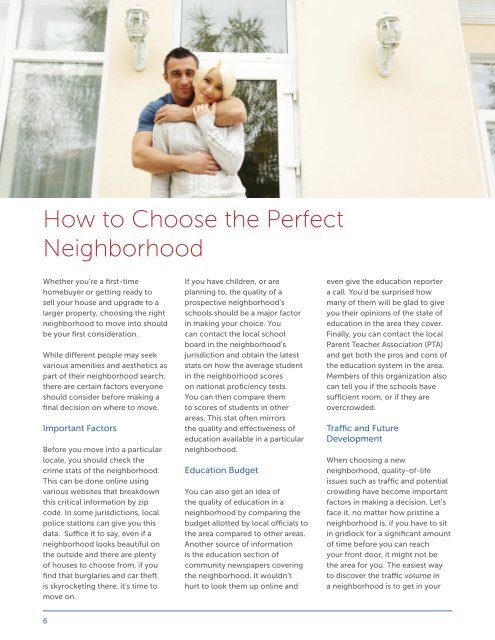Homefit Issue 1 - Trumbull Realty Group
Homefit Issue 1 - Trumbull Realty Group/ Tristan Sherrill www.YourLoanPro.net
Homefit Issue 1 - Trumbull Realty Group/ Tristan Sherrill www.YourLoanPro.net
You also want an ePaper? Increase the reach of your titles
YUMPU automatically turns print PDFs into web optimized ePapers that Google loves.
How to Choose the Perfect<br />
Neighborhood<br />
Whether you’re a first-time<br />
homebuyer or getting ready to<br />
sell your house and upgrade to a<br />
larger property, choosing the right<br />
neighborhood to move into should<br />
be your first consideration.<br />
While different people may seek<br />
various amenities and aesthetics as<br />
part of their neighborhood search,<br />
there are certain factors everyone<br />
should consider before making a<br />
final decision on where to move.<br />
Important Factors<br />
Before you move into a particular<br />
locale, you should check the<br />
crime stats of the neighborhood.<br />
This can be done online using<br />
various websites that breakdown<br />
this critical information by zip<br />
code. In some jurisdictions, local<br />
police stations can give you this<br />
data. Suffice it to say, even if a<br />
neighborhood looks beautiful on<br />
the outside and there are plenty<br />
of houses to choose from, if you<br />
find that burglaries and car theft<br />
is skyrocketing there, it’s time to<br />
move on.<br />
If you have children, or are<br />
planning to, the quality of a<br />
prospective neighborhood’s<br />
schools should be a major factor<br />
in making your choice. You<br />
can contact the local school<br />
board in the neighborhood’s<br />
jurisdiction and obtain the latest<br />
stats on how the average student<br />
in the neighborhood scores<br />
on national proficiency tests.<br />
You can then compare them<br />
to scores of students in other<br />
areas. This stat often mirrors<br />
the quality and effectiveness of<br />
education available in a particular<br />
neighborhood.<br />
Education Budget<br />
You can also get an idea of<br />
the quality of education in a<br />
neighborhood by comparing the<br />
budget allotted by local officials to<br />
the area compared to other areas.<br />
Another source of information<br />
is the education section of<br />
community newspapers covering<br />
the neighborhood. It wouldn’t<br />
hurt to look them up online and<br />
even give the education reporter<br />
a call. You’d be surprised how<br />
many of them will be glad to give<br />
you their opinions of the state of<br />
education in the area they cover.<br />
Finally, you can contact the local<br />
Parent Teacher Association (PTA)<br />
and get both the pros and cons of<br />
the education system in the area.<br />
Members of this organization also<br />
can tell you if the schools have<br />
sufficient room, or if they are<br />
overcrowded.<br />
Traffic and Future<br />
Development<br />
When choosing a new<br />
neighborhood, quality-of-life<br />
issues such as traffic and potential<br />
crowding have become important<br />
factors in making a decision. Let’s<br />
face it, no matter how pristine a<br />
neighborhood is, if you have to sit<br />
in gridlock for a significant amount<br />
of time before you can reach<br />
your front door, it might not be<br />
the area for you. The easiest way<br />
to discover the traffic volume in<br />
a neighborhood is to get in your<br />
6








